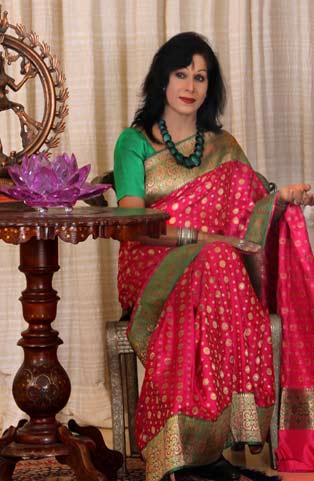
Key Speaker and Chairperson during 1997-2015 (few notable ones)
- "Women, Arts and the Social environment"
The movement related to search for national identity, social barriers, caste and gender divides and their impact on the identity and social status of women in performing arts were the issues touched upon. - "Challenges in the Education System"
The need for a well balanced educational curriculum with a large reach that recognizes and addresses the need for producing a well balanced, mentally healthy, moral and ethical individuals with judicious reasoning, imbued with a spirit of enquiry, sensitivity, humanism and with a sound understanding of India's philosophical and cultural roots while being able to appreciate all cultures of the world not being swept off their feet in the wake of winds of globalization, formed the spirit of her discussion. - "Women Empowerment"
A burning issue regarding the quest of women for equality with men, for attaining equal rights and a voice in decision making process taking cognizance of barriers to women rights that are ingrained in cultural norms - "Environment"
A multi pronged perspective to the issue ranging from pollution, social, natural, physical alive to the fact of existing dynamic set of variables. - "Preservation of traditional arts"
Traditional arts emerge from age old practices spanning several generations and life style of various communities. In the scenario of fast paced globalization, there is an inherent danger of homogenization thus losing out on traditional skills, knowledge and practices. - "Dying and Endangered art forms"
Indian art forms with unique traditions have developed over several millennia exuding the spirit, ethos and flavor of the natural habitat, environment and philosophy, living traditions that became a way of life, availability of resources and uniquely developed skills. With impact from various technological advancements and various cultures, some arts and crafts do not seem to find space in the new environment. To what extent should this be a cause of concern in the natural cyclic phenomenon of new replacing the old? - "The intangible Kathak heritage of Delhi"
In the pluralistic culture a result of its complex history since thousands of years, Delhi's vibrant classical dance, Kathak is a manifestation of its intangible heritage. - "Changing Aesthtics": (Seminar on Kathak, Lucknow Rastriya Kathak Sansthan).
The over two and half thousand of history of Kathak but more so in the last millennium, has seen changing aesthetics in its presentation. - "Creativity and Tradition in Kathak": (Seminar on Kathak, Kathak Kendra, Meghdoot Theatre, Delhi, 2013).
Dynamism and the spirit of spontaneity evident in its presentation and delineation of the abstract (nritta ang) and the textual (sahitya and abhinaya ang), so much hall marks of Kathak reverberate with inherent creativity and tradition. - "Hand Gestures: Comparison of the Shastras"
Indian dance is replete with usage of hand gestures which have been codified in Indian shastras, predominantly the Natyashastra, Abhinaya Darpan and the Srihastamuktavali. Comparison of the hand gestures in the three shastras and their application in Kathak makes a fascinating study. - " Kinetics of Cultural Synthesis"
Indian culture, a complex blend of its historical traditions, has imparted to it a deep seated heterogeneity, which is at once unique and universal. In this process, the Indo Gangetic belt, from where originated its ancient philosophy, the Vedas, Itihas, Smritis, Puranas etc, impacted the development of a way of life that had its echoes throughout the sub-continent. In this process there were several forces and torques, internal and external that had profound effect. Using the classical dance tradition of this vast belt as its central point, the discussion covered several areas of evolution right up to the present scenario. The discussion also included myths and perceptions that have coloured the past and the present impacting futuristic developments. - "Pluralistic Legacy of Kathak"
The Indo Gangetic belt has seen millennia of migrations and invasions that have resulted in a beautiful synthesis of cultures. Kathak, even though rooted in Vedic Brahminism, echoes the secular and pluralistic spirit of the 'Ganga-Jamuni tehzeeb'. - "CSR towards Women Empowerment and Child Development"
With women making about forty eight percent of India's population yet they form less than twenty four percent of the labour market with about two-third of the rural women being illiterate. The country is also home to probably the largest number of children (about 1 billion). Thus it enjoins upon members of society to be partners in the growth, survival and development of women and children. - "Contribution of Women to Indian Classical Dance"
Performing arts sees the largest number of women performers. How they have shaped the direction, the content, presentation and acceptability of this art form formed the core issue of discussion. - "Kathak and the Shastras"
Detailed dissection of the intricate interwoven linkage, impact and applicability of the two genres formed the spirit of the discussion. - "Living Values"
The talk centred on Cultural Contexts, Education, Mentoring and Evaluation systems for Human Development - "Parampara Pravah"
The talk highlighted age-old masterpiece compositions and their aesthetic aspects. - "Narrative Traditions: Dance"
In India, all art forms have journeyed through several millennia through the medium of oral handing of performing arts. Over time and space, the narratives have evolved reflecting historical memory and social changes. - "School education : a rethink"
To meet the challenges posed by changing pace and impact of globalization, changing dynamics of relationships and psychology, changes required in school curriculum for development of a healthy (in mind and spirit), reasoning, judicious individual formed the key note of the discussion. - "Ageing in the context of classical dance"
Ageing is a natural process. How this has been tackled, is being tackled and should be tackled was the essence of the discussion.




 Shovana Narayan
Shovana Narayan  Mob: +919711543781, +919811173734
Mob: +919711543781, +919811173734 Email :
Email :